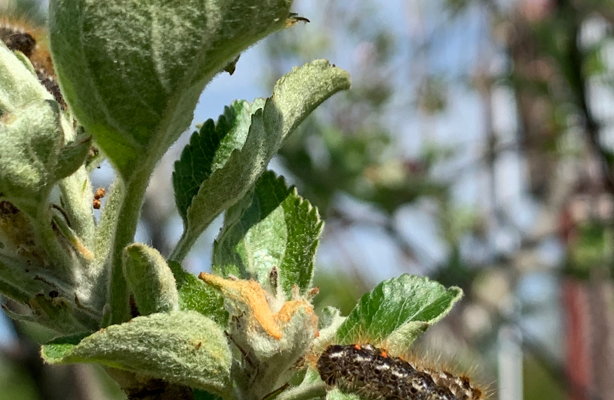
Browntail moth spread could depend on weather this spring
By Elizabeth Walztoni, Bangor Daily News Staff
Browntail moth caterpillars are emerging from their nests this week. How fast the invasive insect’s population will expand likely depends on spring rainfall, according to the Maine Department of Agriculture, Conservation and Forestry.
“It’s really cautious optimism,” state entomologist Allison Kanoti said of this year’s outlook.
The insects have spread into inland Maine from Massachusetts within the last decade and were recorded in more than 46,000 acres of the state last year. Their hairs cause a painful rash on the skin lasting days or weeks and respiratory problems when breathed in. The caterpillars also defoliate trees.
If the state receives a typical amount of precipitation this spring, disease could spread in caterpillar populations and cause a collapse, the department said. A dry May and June will likely lead to continued spread.
“It seems that there is kind of a Goldilocks situation,” Kanoti said.
In a wet season, fungal spores and viral infections multiply. Caterpillars also spend more time together, spreading diseases in their own population. The department saw numbers drop in the Capital region after a wet July several years ago, the first since browntail moths began to spread widely in 2015.
A spring that’s too wet could mean less spore transmission of fungal disease. The state had high hopes for a decline with last year’s wet season, but populations ultimately expanded by more than 30,000 acres, especially in Penobscot, Waldo, Hancock and Knox counties.
If populations die off in one region — like around Augusta, which Kanoti described as a “doughnut” of browntail-free area — they can still return in later years when weather conditions change.
The department has found some evidence of caterpillars dying outside of their nests in the Penobscot Valley this spring, one point of cautious optimism, though not at the level seen in Augusta.
The window for agencies and landowners to cut nests from trees has just passed, but insecticide treatments are best completed this month, according to the department. Preventative treatments should be finished by the end of May.
Risk can be reduced by avoiding known caterpillar nesting areas, putting poison ivy lotion on exposed skin before heading outside and turning off outdoor lights or changing them to yellow-spectrum LEDs to avoid attracting new populations, according to Kanoti.
The Maine Department of Agriculture, Conservation and Forestry is monitoring browntail caterpillar development and disease each week in Bangor, Belfast, Bridgton, Brunswick, Dover-Foxcroft, Hancock, Lincoln, Newport, Turner, and Unity this year.